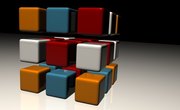A career in interior design demands creativity and technical skills to transform stale, impractical spaces into lively, functional settings for various purposes. Pursuing a profession in this field requires sufficient knowledge of perspective, measuring and calculating formulas, and understanding how visual elements can influence a person.
Drawing Classes
Interior design focuses on the use of space within a particular area or environment. By taking drawing classes, students can prepare themselves by being familiar with space, scale, depth perception, angle perspective, proportion and color. The Interior Design Tutor website says students in college or advanced interior design programs must take drawing classes to practice how to sketch realistically. Many interior designers continue to use hand-drawn blueprint drawings on display boards for potential clients to view, despite the availability of digital software programs.

Geometry Classes
Geometry courses will help you become an expert in measuring and calculating lengths, volumes and areas, all extremely useful skills when planning a space for placing furniture or other decorations in the room. Basic knowledge of math helps you estimate costs of merchandise and supplies for any design projects. You should also train yourself to understand proportion and scale. The correct size of furniture and decorations must correspond to the area you're working with, so that it creates fluidity of objects in the room.

Psychology Classes
According to the Remodeling My Space website, psychological studies about the way people react to certain colors, shapes, and images provide data on the moods for each distinct setting. A space's design and decorations can have a considerable influence on people's emotions, and a successful design caters to what the client wants to achieve through the space.
The U.S. Bureau of Labor Statistics reports that in retail stores, an effective design layout can increase sales by drawing more customers into the store and into specific areas of the store. A well-furnished home can also affect real estate sales by attracting potential buyers. The specific color scheme for every environment needs to be carefully chosen according to the appropriate setting and mood the space needs.
The Demesne website says that some interior designers utilize these psychological principles into creating a pleasant, aesthetic design for a space. It also reports that warm colors such as red, orange, yellow and brown can increase metabolism and rouse appetite. Cooler colors like purple, blue, green and gray are thought to calm, soothe and relax viewers.

Related Articles
References
Writer Bio
Since 2009, Amanda Lee has been a technical writer and editor, developing website content and producing articles for various companies. She has written articles for sites such as eHow and Answerbag, specializing in education and career topics. Lee is pursuing a Bachelor of Arts in English at Biola University.











